Initial Brainstorm
Moodboards and Spotify Playlists
Amanda
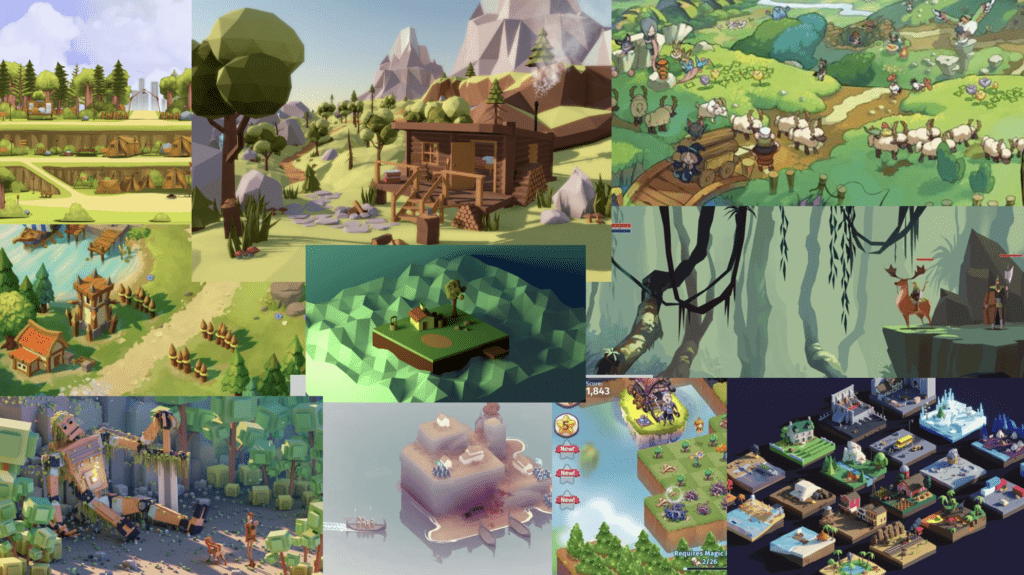
Anna

Selaine
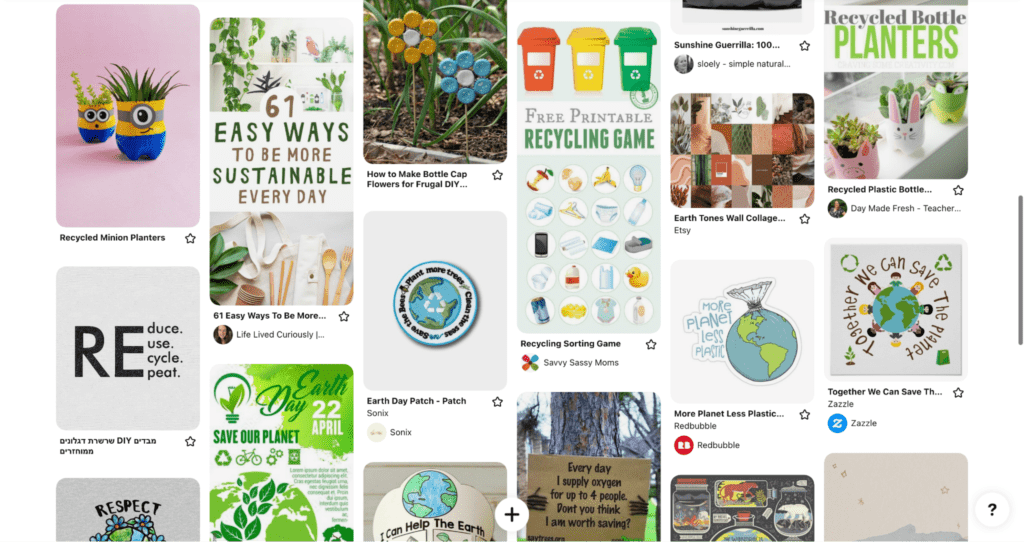
Wilmer
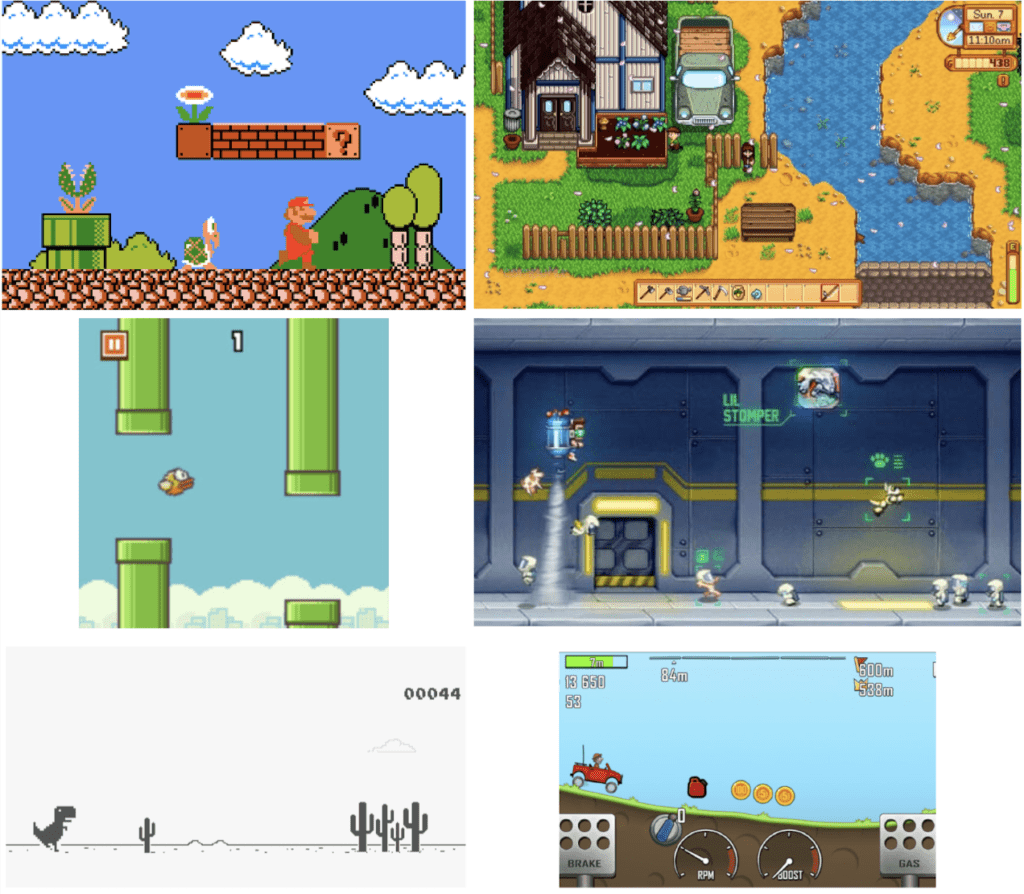
Initial Team Medium Article
Team Concept Doc (Checkpoint 1)
Individual Medium Articles
Map of Chosen System
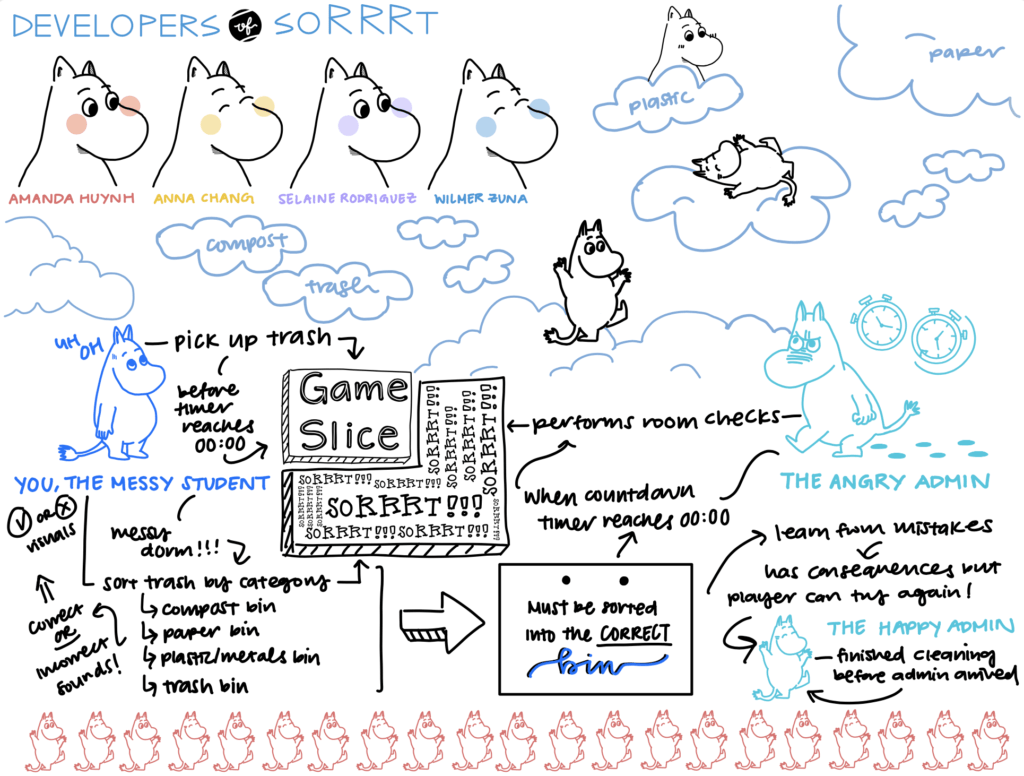
Design Process
Artist’s Statement
In creating soRRRt, we hoped to create a fun and enjoyable experience that allows individuals to feel challenged, both through the game mechanics but also through learning more about how to sort their trash! As climate change continues to be a worldwide issue, we hope to encourage individuals to make changes in their lifestyle that will help them be more environmentally friendly, starting with the small things such as sorting their trash. At institutions such as Stanford, we often have bins everywhere that remind us to make a good decision when sorting trash, but not everyone has that luxury, which we hope to counter through this game.
We aimed for a light-hearted, clean, and simple look to our game, relying on an 8-bit and pixelated feel. Through the basic controls (arrow keys and space bar), individuals can navigate the entire space and learn to pick up and move trash relatively quickly, focusing on how to beat the time crunch while also cleaning up the space. As the timer runs down, players will feel pressure to sort correctly, relying on their own memory and the importance of taking care of the environment to get them to the end of the level!
Target Audience
Our target audience was individuals who are old enough to learn about sorting trash, and generally individuals who have their own space to clean and make decisions about. When we center our focus on people who have autonomy over their space, we can encourage them to make environmentally conscious decisions for the spaces they are a part of. Our storyline follows the life of a college student, with students often struggling to maintain a clutter-free living space in their tiny dorm rooms. However, this game is not only for college students and can be played by anyone interested in beating the boss during the short time period and sorting everything along the way! Since there are no inappropriate elements for younger players, we can see the age range fluctuate, as long as the players understand the mechanics themselves.
Formal Elements and Core Concepts
When it comes to the formal elements of game design, soRRRt incorporates the following into its design:
- Players: Our game was designed to be single-player, and only has controls and one main player integrated into the scene.
- Objectives/Goals: The objective is to pick up all of the trash within the scene, and deposit the trash within the appropriate bins. The ultimate goal is to sort all the trash within the time constraints.
- Story: The story is predetermined, and begins with the life of a college student. As a student struggles through the semester/quarter, their room becomes chaotically messy. One night, they receive an email that there will be “wellbeing checks” that night and that a Dorm Admin will be coming to check the status of their room.
- Actions: The player can walk around the room using their keys or pick up and drop items using the spacebar.
- Boundaries: The game ends as soon as the player walks away from the level/computer. More specifically, the timer embedded within the game will end the level (depending on player progress) and create that additional distinction between the game and reality.
- Rules: The main rule of the game is that all the trash must be sorted by the end of the timer. Secondly, the trash must be sorted into the appropriate bins, otherwise, the sorting will not be accepted by the game. The player is also constrained to the bottom half of the screen, as the boss strolls along the top section.
- Outcome: The player either wins or loses. Although they may feel as if they are progressing, the end screens will either be a failure (not all trash sorted) or a success (all trash sorted), so the player only has these two specific outcomes.
For other core concepts of the class, we integrated them in these forms:
- Game Architecture: The architecture of the game was designed to provide constraints for the sorting space, as well as obstacles. The obstacles involve the other pieces of trash we must walk around to reach the trash cans. The trash cans themselves are also a form of obstacle, as we must know which trash can is appropriate. Lastly, the bedroom elements we chose were supposed to feel familiar, and help the player feel more comfortable in the space they are navigating.
- Space and Narrative: We provided a very clear-cut narrative, as we hoped that would allow the player to feel aligned with the emotions/worries of the main character, and feel the pressure to sort trash efficiently. We designed the space to feel familiar, so the narrative took precedence over how the player would interact, rather than be absorbed with the graphic design elements.
- Game Progression: Since we created a slice, instead of a minimum viable product, the progression of our game mostly relies on the transitions between the tutorial, gameplay, and end results. We will discuss that in a later section as we look into the details, but we relied on screens, background screens, sounds, and other features to showcase the differences in scenes. In terms of what we imagined for a larger game progression, we would’ve liked to add multiple layers with different amounts of trash, new trash that users must figure out how to sort on their one, and different time constraints. This would keep the game interesting across multiple levels!
- Game Onboarding: For our tutorial section, we did not align with the better examples we had seen in class. In lecture and in the Plants Vs. Zombies video, we saw that the best way to introduce a player to a game and keep them coming back while learning/growing is by having them play small initial levels. Rather than just discussing the rules like in a board game, it is best to let players start with simple levels that they can explore, and thus learn the rules on their own. Since we designed a Slice, rather than a Minimum Viable Product (MVP), it was more difficult to integrate various tutorial levels that would have explained all the different pieces of trash and how to pick up/deposit each. We wish we could’ve added this to our game and seen how that would’ve changed everything.
- Balance: When determining balance, we relied on a few different variables to manipulate the difficulty such as time, number of trash present, and more. We discuss this more towards the bottom of our write-up!
Our Main Design Process
We first decided on the style of our game, which was an 8-bit or pixelated approach. Many of the games we played growing up were in this style and had a comfortable nostalgic feel that we wanted to emulate. From there, we decided on the items we would need within the game scene (dorm room, trash cans, trash elements).
For the items, we decided to hand-design the elements. It took us some time to find tools that would allow us to get the look we wanted, but a few iPad applications and websites such as Piskel allowed us to get the look we wanted. From there, we each worked on designing different elements such as the trash elements, the dorm room, trash cans, the main player, the boss character, and more. Each element in our game was designed/drawn by one of the co-developers, so each graphic element is completely our own.
We made many iterations of each design, including completely scrapping some drawings that were not recognizable enough to be easy for the player. Continuously, we made difficult decisions such as deciding against our initial trash can designs. During initial playtesting, we were told that the letters on the trash cans were not intuitive enough to understand. Instead, we decided to rely on the colors of the bins only, and instead have the tutorial explicitly point out the differences between the bins. This would lead to one of our major design conflicts, where the bins are not distinguishable besides the color. For individuals who are visually impaired, this may make the game inaccessible to them, as there are no other ways for them to see the difference. Besides that small difference, we felt that the rest of the game was relatively accessible, as the rest of the graphic design elements have significant differences in shape and size.


We would like to acknowledge that the sound elements are supplementary and add to the game experience, but are not at all required. In order to simulate the urgent feeling created by the gameplay music, we also have the boss walking up and down the hall and the large timer. For the act of sorting trash, we have visual cues that tell the player if they were correct or not, which cover the feedback that players may need to know their progress in the game. The supplementary nature of the sounds allows this game to be accessible to the hearing-impaired community and still be accessible to all.
Game Walkthrough
We have three distinct sections of our game that the user will take part in.
Tutorial
Because we decided to pursue a slice, rather than a minimum viable product, we tried to keep the tutorial simple. As discussed previously, this was a design trade-off but allowed us to focus more on the game content itself. Therefore, the tutorial is just a section of screens that provide background, control information, and rules for how to be successful in the game. The player navigates through these screens by clicking the next button.
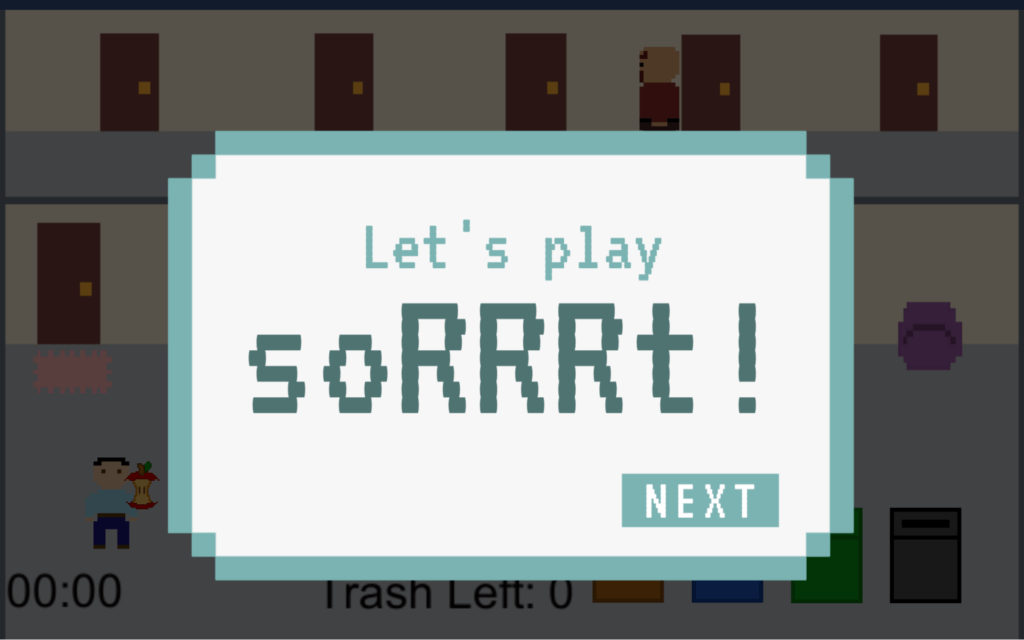
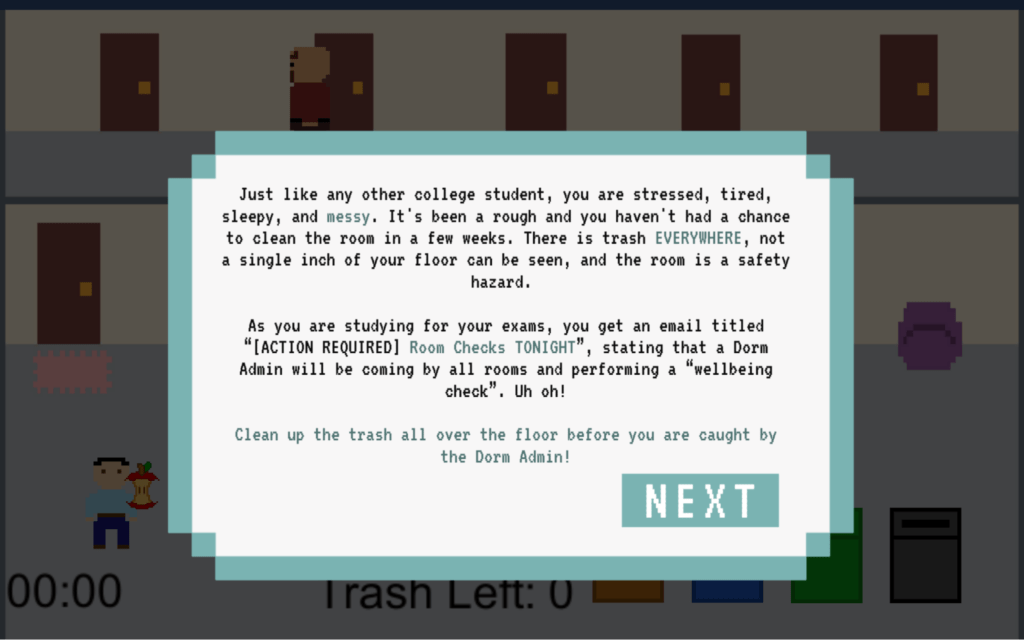
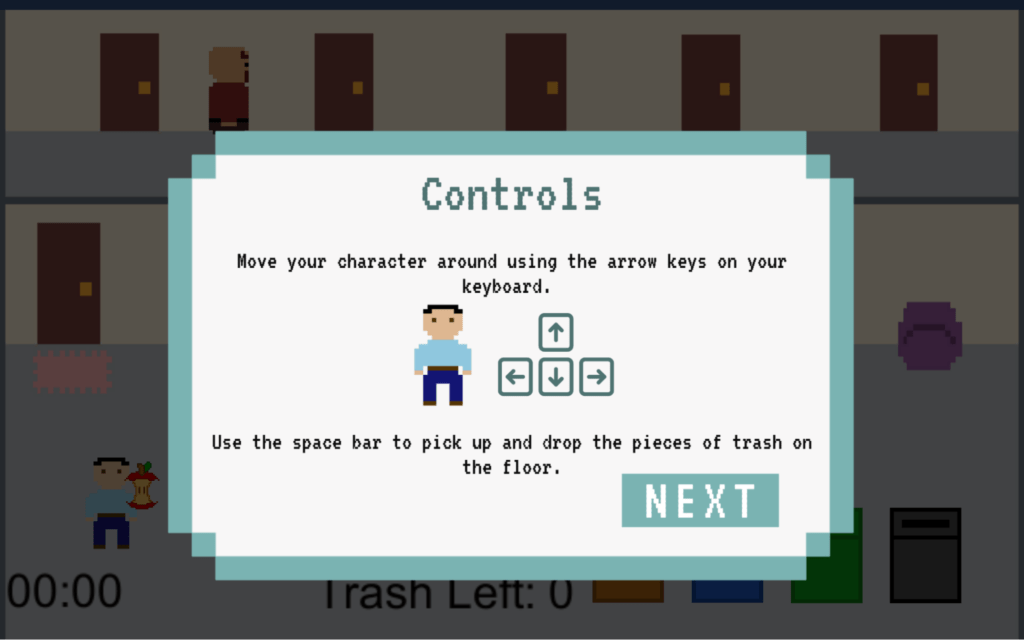
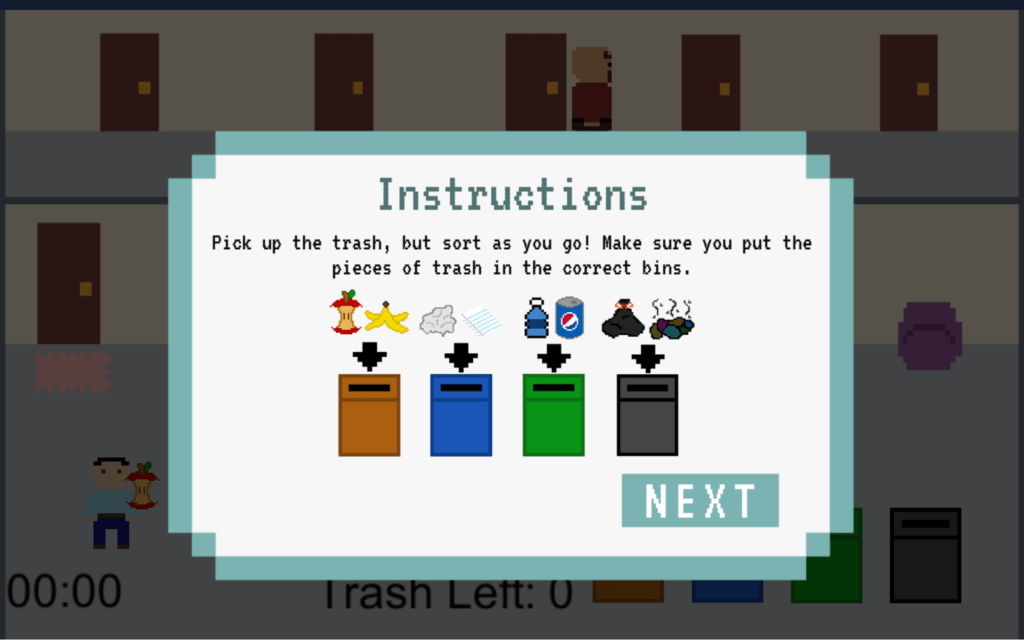
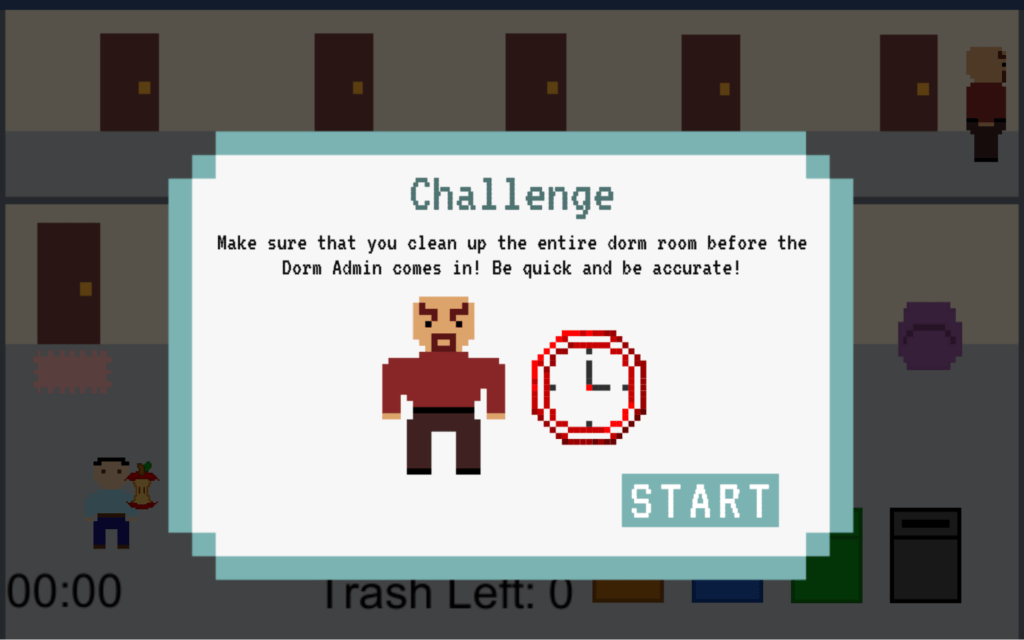
Gameplay
Once the player hits start, we will see the full gameplay scene and the timer will begin. The scene itself has two sections, the bottom portion which is the player’s bedroom, and the top portion which is the dorm room hallway. The top portion has many dorms and is where the Dorm Admin is strolling, waiting to check your room. The bottom portion has the timer, trash left counter, four different trash bins, and pieces of trash we must sort. There are also dorm items such as a bed, desk, window, dresser, chair, wall decor, and a plushie. The user must run around this space and sort the trash on the floor into the trash bins in the bottom right.
Based on if they sort correctly or incorrectly we will see feedback provided through emojis, as well as the trash disappear or continue (needing to be sorted correctly). The user must sort all the trash for the level to finish, or the timer must run out, whichever comes first. The following screenshots will showcase examples of gameplay, and the Alt Text will provide thorough explanations:
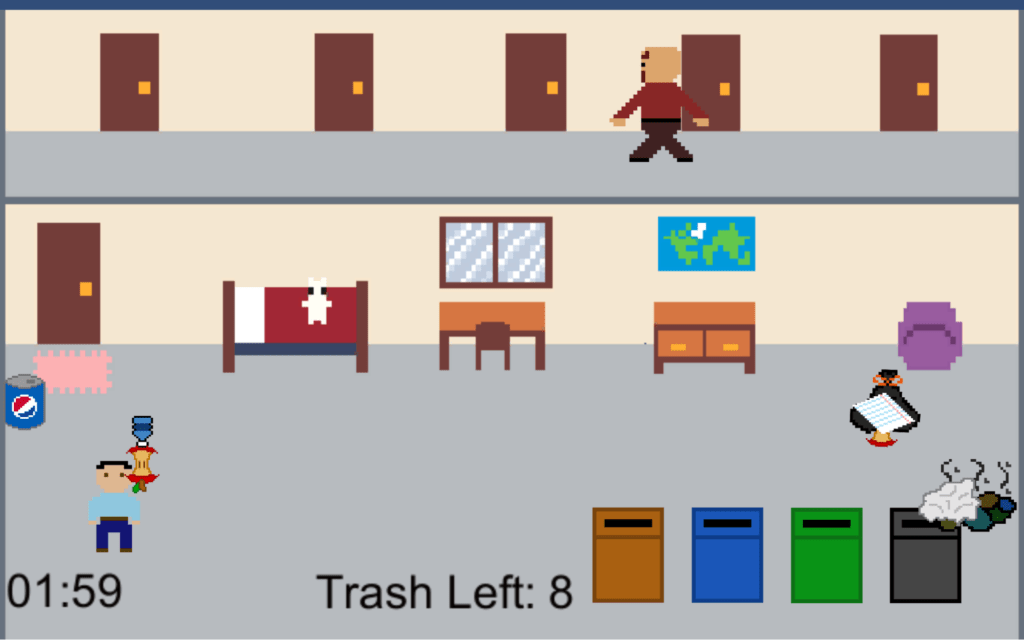

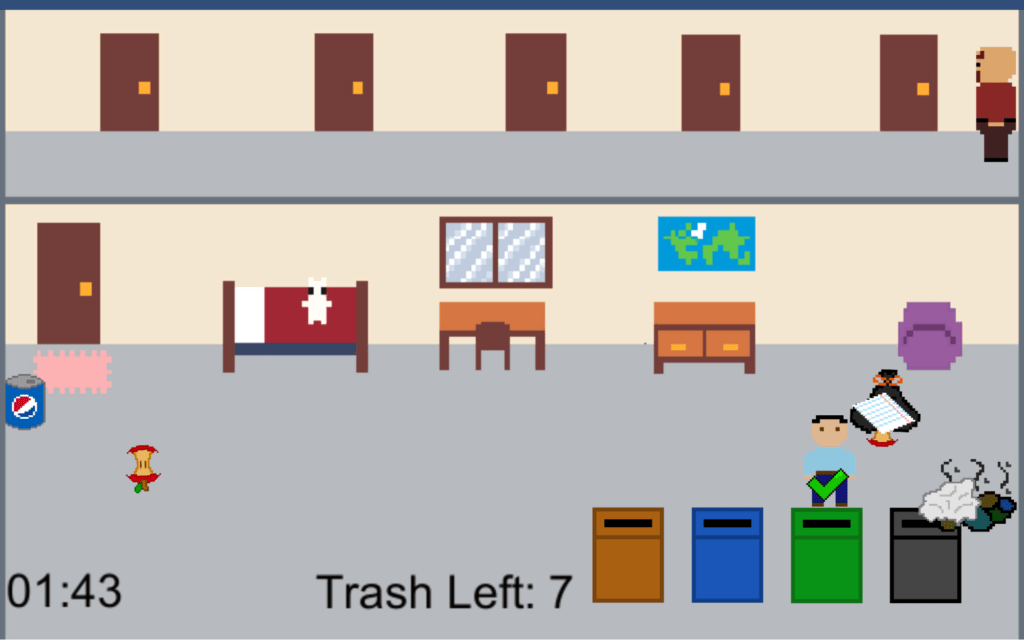
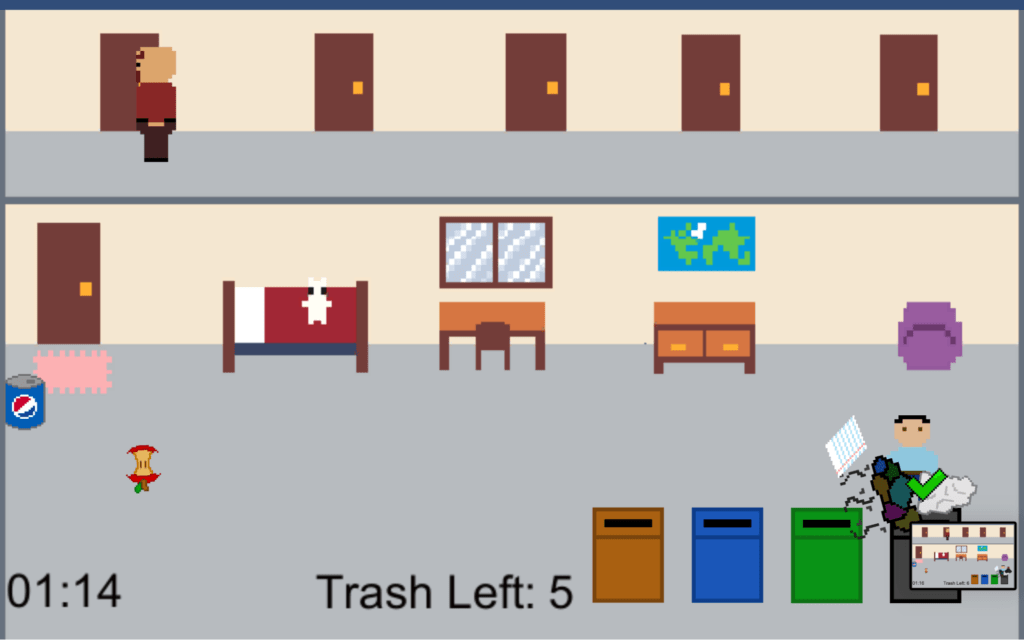
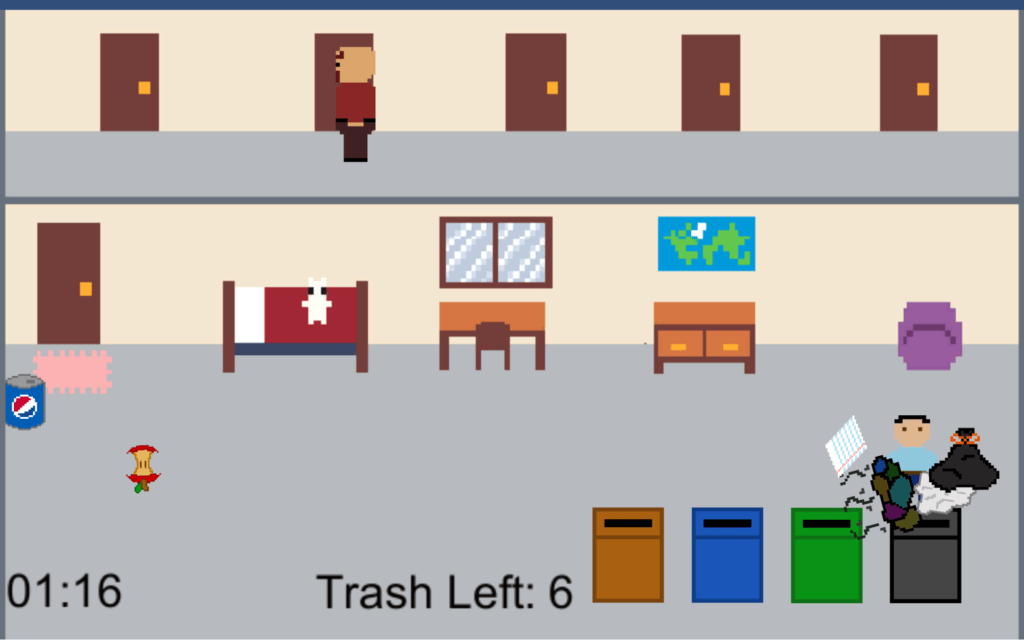
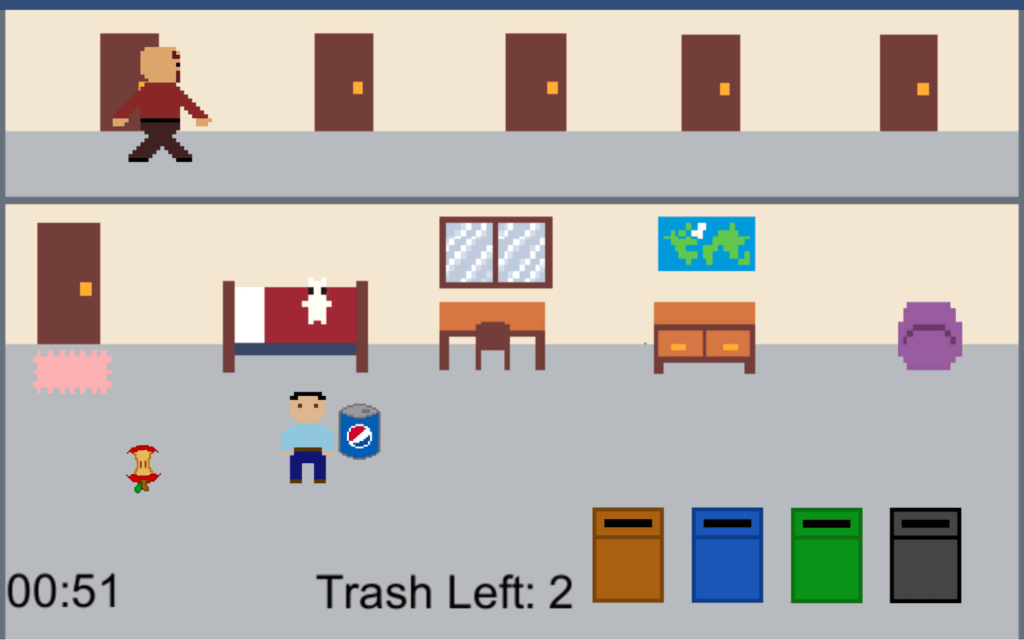
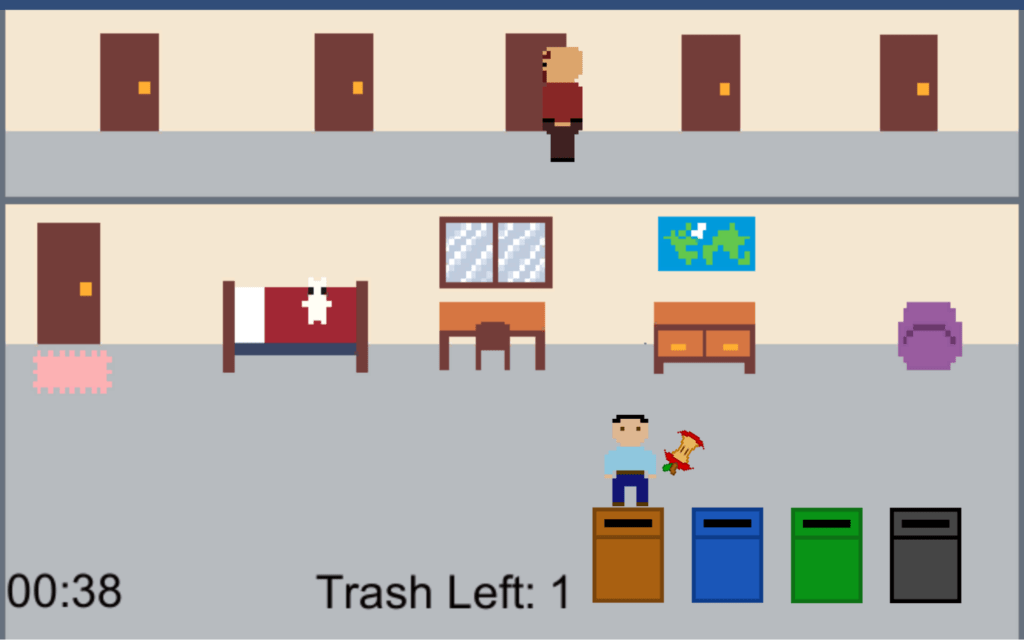
End Scenes
There are two possible end scenes for the game, either the player sorts all of the trash in time, or they do not. If a user runs out of time while sorting (even if they only have one piece of trash left), it will still be considered a failed level. Based on those two possibilities, we have these two end screens:
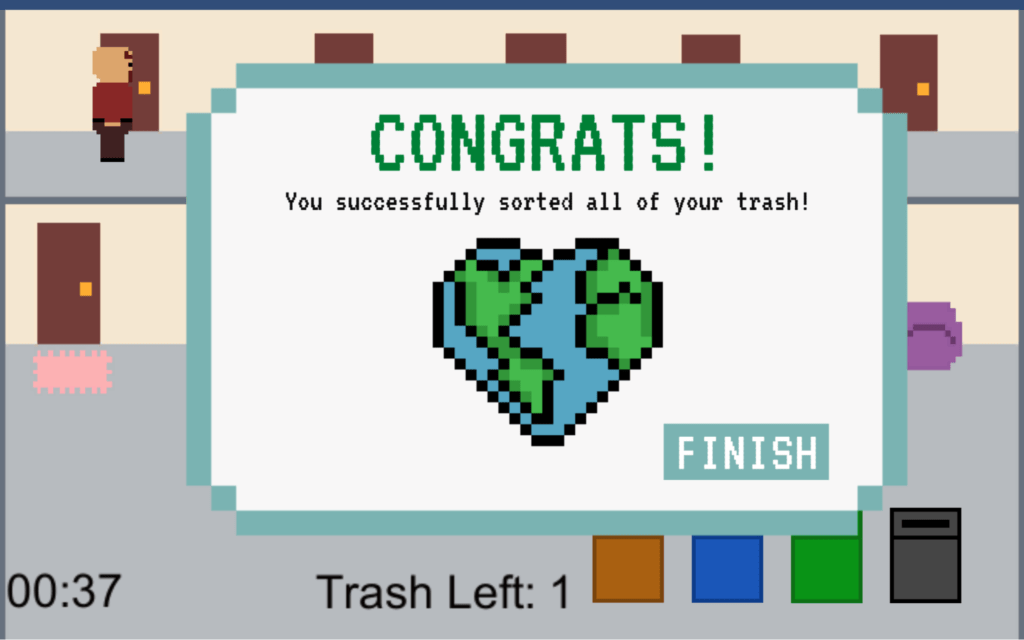
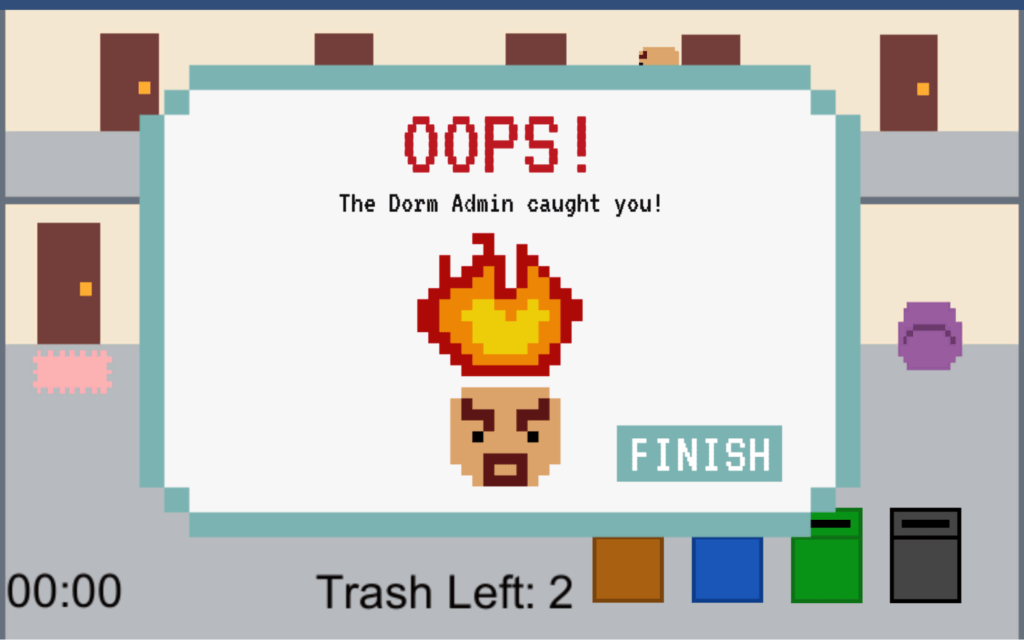
Game Link
Playtesting and Iteration
In-class playtest #1
In this first playtest with a fellow classmate, we were testing to see if the controls of our game were intuitive. Our game uses your computer’s space bar to pick up and drop items, and the four arrow keys to control movements. Although we wanted the mechanics to be easy-to-learn, we also wanted to make sure the game was challenging enough.
The tester mentioned that they liked how they could push past objects in their way simply by running into them. They also noted the movement was a bit slippery, like ice. Although this was a little strange at first, they felt that it added a challenge, as more precise movement requires more practice.
The tester left us with other suggestions, such as incorporating power-ups or some sort of punishment (like slower movement) if an item is sorted incorrectly. At the time, we had not yet finalized the background image, so a concern they brought up with differentiating items in the background image from the trash items that they could pick up. They suggested making the items hover slightly up and down to make it clear you can pick them up. In order to fully resolve this problem, we decided to design a background image with a completely clear floor and only background details along the back wall. We then moved on to focusing on the graphics for the next iteration.
In-class playtest #2
In this second playtest with two fellow classmates, we were testing to see if the graphics and additional features like the tutorial and timer were effective.
Some issues that came up were that we had some trash spawn outside of bounds reachable by the player. The trash would sometimes just be separated from the character, and players were required to stand on top of/behind a trash can in order to deposit trash, which was not very intuitive.
A concern players mentioned about the game is what to do if they forget where the trash goes. They also felt that the tutorial was a bit text-heavy. Suggested solutions include adding some sort of “help” button for players to click for a reminder of the different trash categories, and a tutorial that is instead a simplified version of the game itself, like with one piece of trash and one bin.
Players enjoyed the amount of trash spawned and the feelings evoked by the “boss” who monitors the halls at the top of the screen. That, along with the music and the timer, created a feeling of urgency.
For the next iteration, we focused on resolving the mechanical issues with picking up and depositing trash. We also added music changes to help create mood shifts throughout the gameplay. Other suggestions related to the tutorial and help button would be great to incorporate into later iterations.
Playtest #3 (conducted by Selaine)
Both players expressed confusion about whether the trash or the character needed to touch the trash can. The trash getting separated from the player was a recurring point of frustration.
One player felt the time crunch made them feel a bit stressed out. They also forgot some of the controls after going through the tutorial. However, they enjoyed the sounds and thought that important items (pieces of trash) were clear, though one item (the water bottle) was a bit small. Issues with the presentation of the main character were brought up. Ways of customizing the character would make the game playing experience more inclusive.
The second player also sometimes forgot which bin is for what. They also brought up issues of color blindness and suggested adding sounds to indicate when something is picked up or dropped.
Playtest #4 (conducted by Wilmer)
It was not intuitive for the character, rather than the trash, to be positioned on top of a bin in order to deposit it. Both players thought the game was fun, quick, and intuitive. However, one of them had issues picking up the trash and did not finish in time. Different players require different levels of difficulty, which can be adjusted through the amount of time provided for the level and the number of trash pieces to sort.
Playtest #5 (conducted by Amanda)
Again, the main issue was that it was unclear that players need to move on top of the bin to deposit trash.
Overall, we took the feedback from each of these playtests and integrated them into our bug fixes and the decisions we made for our final result.
Game Balance
When designing the game, we wanted to maintain a level of difficulty that allowed players to feel comfortable while also challenging them to learn more about sorting. Making environmentally-friendly decisions every day is extremely difficult, and we wanted to simulate that within our game. To create a comfortable nature, we created game elements that would be easy to recognize (from the Western perspective). We hoped this would lead to fewer onboarding challenges and allow the actual difficulty to come from the game challenges rather than design challenges.
In order to manipulate difficulty, we had many factors we could experiment with, such as the number of trash pieces and the time allowed. We settled on two minutes to provide a time window for players to figure out the controls and get comfortable with them (due to the minimal hands-on experience in the tutorial). The rest of the time could be spent actually sorting! In most play-tests, we spawned about 6-8 trash pieces. Although these were randomly generated from our options, we hoped having more would result in players having to sort into all four trash bins. This means they’d have to use logic to remember where to sort the trash. Overall, we feel that the difficulty level was comfortable for most players, and many playtesters wanted to play more than once so they could make sure they passed the level!
Final Playtest Video
Final Playtest Reflections
Amanda Huynh (Moderator)
In our in-class playtest on May 26th, I was moderator for our game. At the time of this playtest, we had yet to merge all our changes into the main branch so we had the playtesters view the instructions on one laptop and play the game on another laptop. I noticed that our playtesters were confused about how to deposit the trash into the trash bins after they picked up objects, and verbal cues were helpful. Our playtesters enjoyed our game theme and general aesthetic but wished it was more beginner-friendly. We acknowledge that our game is a slice and not an MVP of the full game. In future iterations, we hope to have a tutorial that does not feel like a tutorial and more beginner levels in the game so players can level up at their own pace.
Anna Chang (Notetaker)
For the in-class playtest on May 26th, I took notes for our game. Our game changed a lot from previous iterations, so I was excited to see what our classmates thought. The controls were a bit buggy still, with the issue of the trash pieces becoming separated from the player but still “grabbed.” These situations required the moderators to verbally explain, as it was not very intuitive. This, along with issues of players finishing the round early and having to wait until the timer stopped, guided us on what final touches to add. Overall, while taking notes, I noticed that the players were all very excited to play our game and were most impressed by the visuals and music.
Selaine Rodriguez (Moderator)
For the final in-class playtest on May 26, I was moderator for the game. I have consistently acted as moderator throughout the length of this class, so I felt comfortable looking out for signs of surprise/discomfort/shock/etc. from the player, and then probing those experiences with more questions. As mentioned above by Amanda, at the time of this playtest, we had many merge conflicts that led to our game being showcased across two different devices. I was intrigued by how one of our playtesters thought that the controls were very intuitive, while the other thought that it was not beginner-friendly enough. By relying on familiar images, the style was very clear to them and enjoyable despite these different experiences with the (sometimes finicky) controls. Across all playtests, people enjoyed how the changes in music allowed them to feel rushed/hurried but not extremely anxious about finishing the game in time. Our in-class final playtest was not the final product that we created, but was extremely helpful for our last-minute fixes.
Since I was mostly moderating for our project, the only game I playtested for this project was Secrets of Stanford. This was a more rough version of their game but was still incredibly fun to play! Their puzzles were constructed very well, as they relied on multiple forms of investigation in order to tie everything together. One of their puzzles relied on connecting letters, the other relied on connecting dates, and lastly connecting context across items. Their use of different forms of puzzles was good as it allowed multiple ways for the player to win, or for players to work together based on each other’s strengths. Overall, it was a very fun game to play.
Wilmer Zuna (Playtester)
I playtested for the teams “Locked Door Office Hours”, “Surviving Cherry Hills” and “Minecraft Prison Break”. I will say the play-testing had me very excited about where the teams were heading with their final products. It was super fun to play games at such high fidelity in the format they had. I provided the corresponding feedback to the teams regarding my play experience. Overall, my experience was positive, with feedback surrounding the structure of the player experience and with recommendations to focus more on the target audience and accessibility.
The most memorable play-testing experience I had was with the “Locked Door Office Hours” team. The Team worked on an Escape Room project and showed us a glimpse of their challenges and mini-games. My main feedback was that their mini-games could be more accessible by providing subtitles, along with alternative formats of interaction in case players are not able to interact with the originally intended medium of interaction. Given that the team’s target audience is the general public, I believed this feedback was useful for their intentions in order to reach greater audiences.
*Selaine, Amanda, and Anna were designated as moderators and notetakers for soRRRt’s final playtest and did not play any other team’s game during the final playtest on May 26th.
Conclusions and Next Steps
Overall, we had a great time designing this video game! After seeing how the play-testers responded to the game, we would love to keep working on games such as this one, which encourage people to tackle real-life problems through simple and challenging puzzles/tasks. Many of the players felt that slight pressure to beat the Boss, but had fun while doing so based on the smiles on their faces and the minimal feedback. We hope that many others can enjoy playing our games as well.
If we had the opportunity to expand on our game, we would do so through the following additions:
- Create a more hands-on tutorial experience that allows players to discover each trash piece and gain experience slowly
- Integrate a count-down system between tutorial and gameplay for smoother transitions
- Add more trash so players will have to engage more with critical thinking
- Add a star-based or point-based feedback system at the end of each level, rather than just success and failure
- Convert from a slice to an MVP so we can work on developing game flow as a whole
Thanks for reading about our development of soRRRt! 💚


